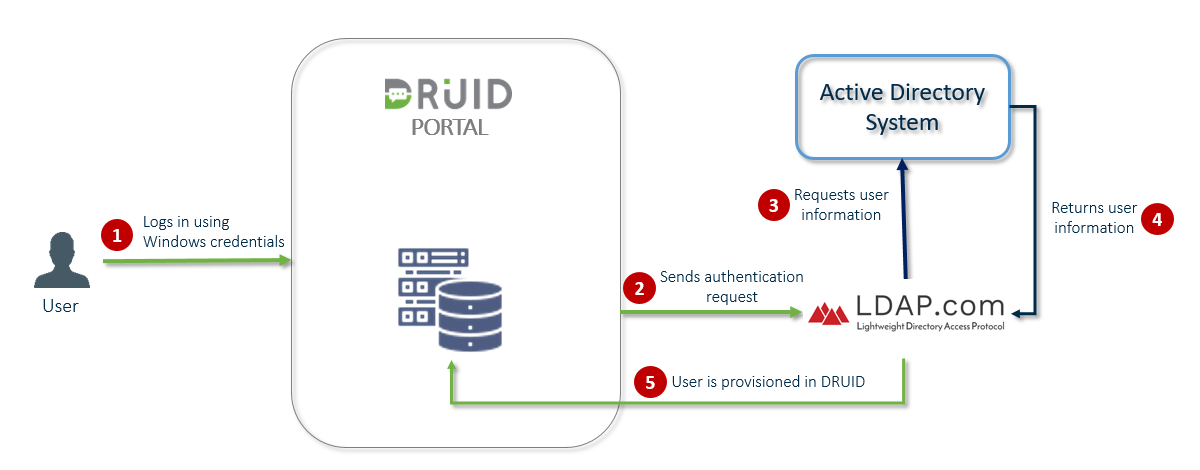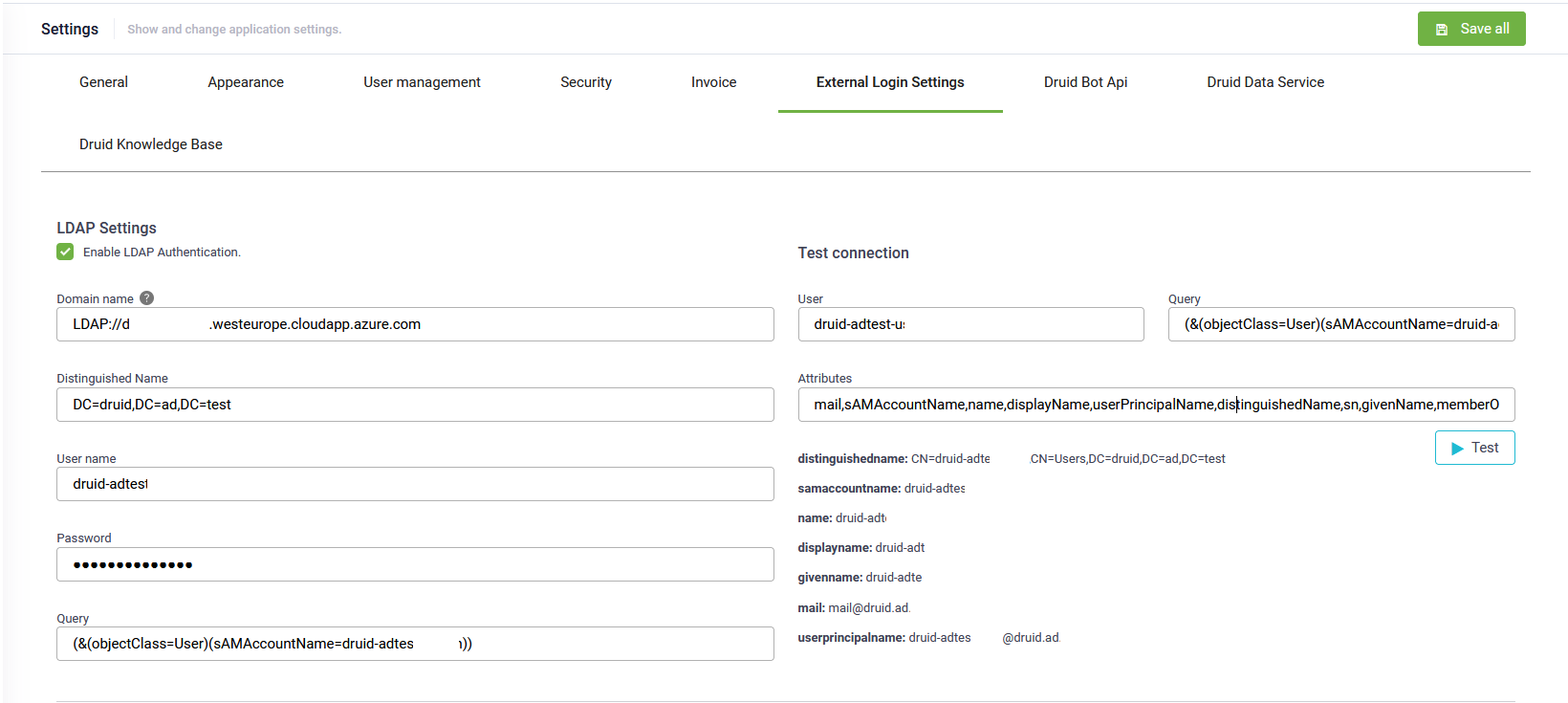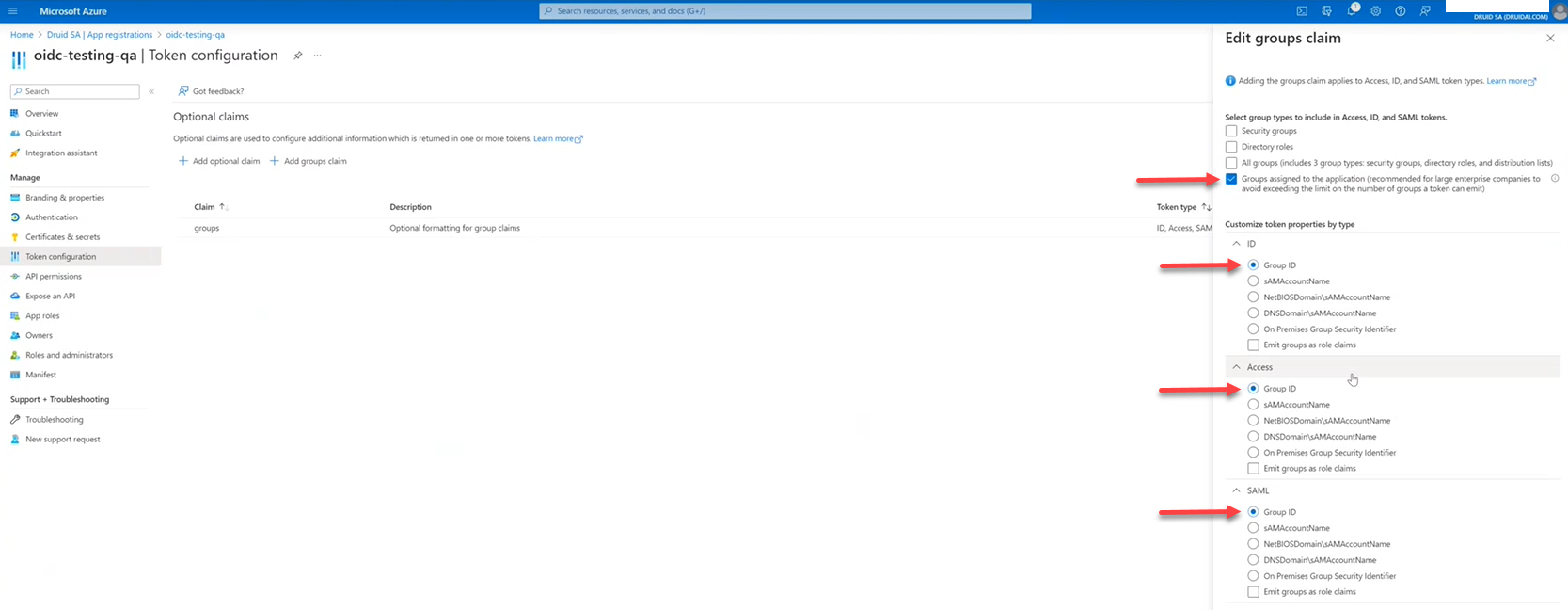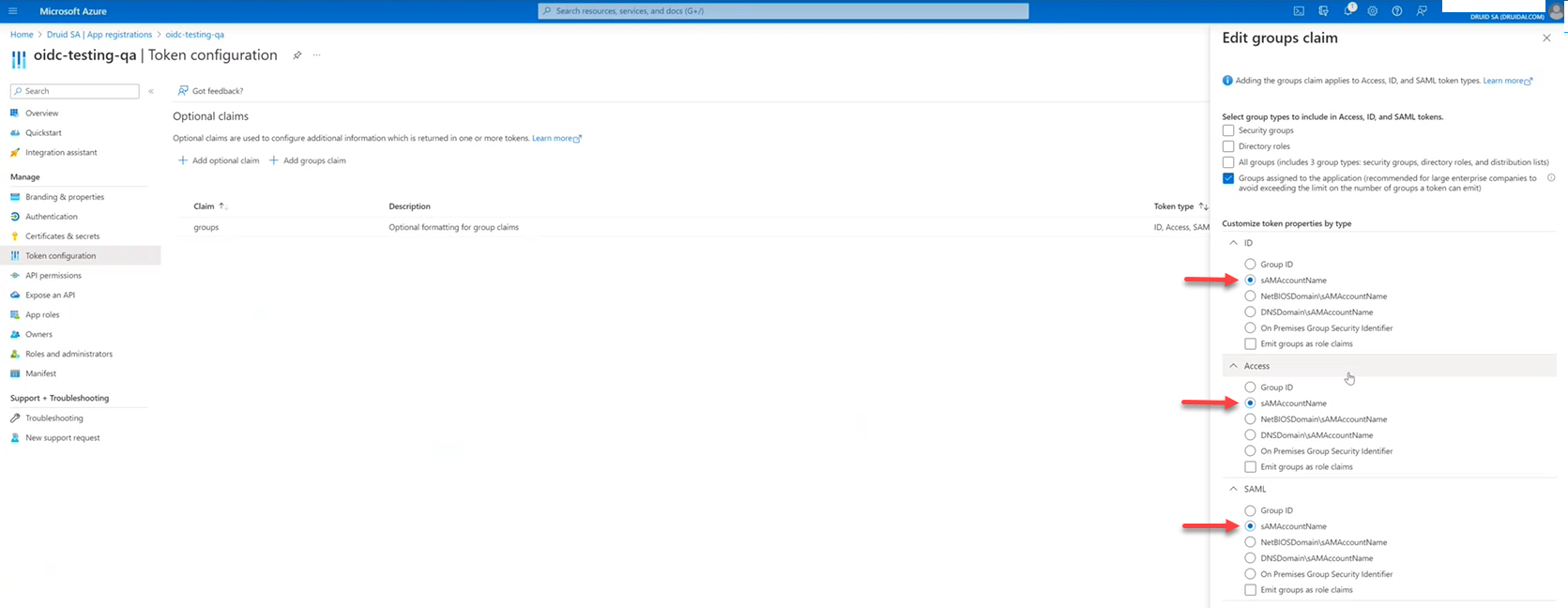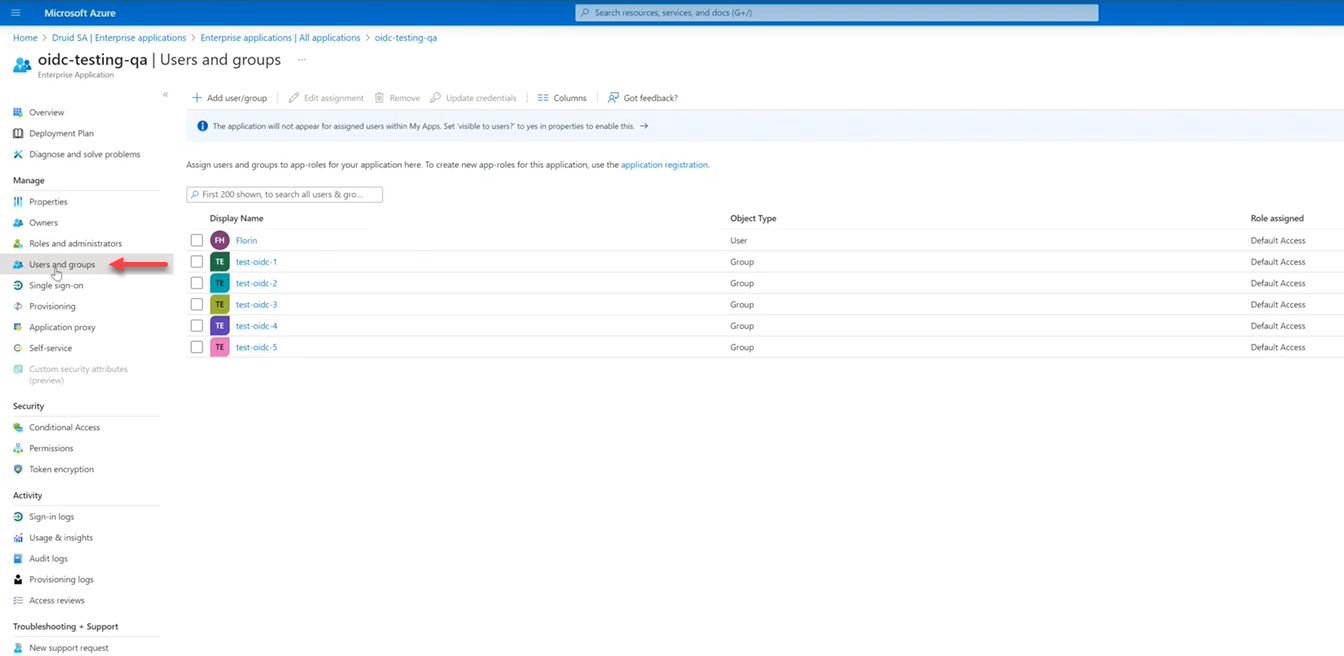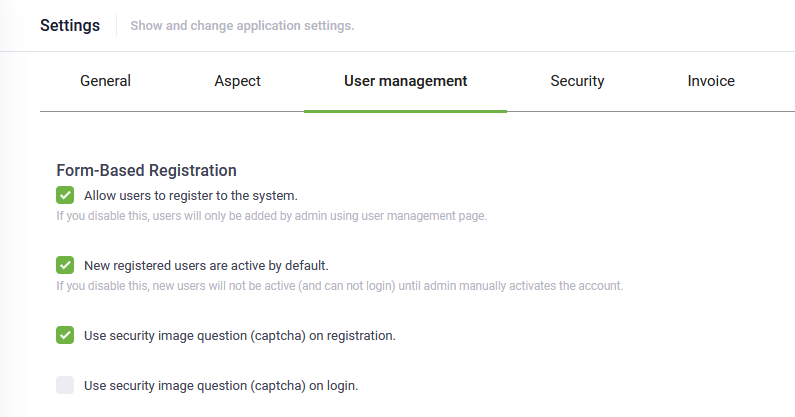Provisioning Portal Users with Active Directory via LDAP
The Lightweight Directory Access Protocol (LDAP) makes it possible for DRUID to query user information from the Active Directory.
By using LDAP authentication on your DRUID tenant you ensure that all your Active Directory (AD) users logging into the DRUID Portal with their AD account credentials (Windows credentials) are automatically provisioned in DRUID at their first login and are being granted with the default security roles.
The figure below provides an overview of how DRUID Portal authentication with Active Directory via LDAP works.
Prerequisites
- You have an Active Directory user with elevated privileges to view Active Directory users and access to the following attributes: "mail", "sAMAccountName", "name", "displayName", "userPrincipalName".
- You have a DRUID Portal admin account.
This section is for DRUID Portal administrators in charge of managing Portal users.
Steps 1. Set up roles for automatically provisioned users
To set up default role(s) to be assigned to automatically provisioned users, from the Administration menu, click Roles. Edit the desired role(s) by selecting Default.
Whenever new users log in DRUID Portal for the first time, they will be assigned with the default role(s).
Steps 2. Set up DRUID Portal authentication with Active Directory via LDAP
To set up DRUID Portal authentication with Active Dorectory via LDAP, in DRUID Portal, from the Administration menu, click Settings and in the Settings page, click the External Login Settings tab.
In the LDAP Settings area, select Enable LDAP Authentication. Set the LDAP details described in the table below.
| Setting | Description |
|---|---|
| Domain name |
The server address or name where the Active Directory service is running. DRUID supports both LDAP and Secure LDAP (LDAPS) via the standard ports (port 389 for LDAP and 636 for LDAPS), therefore in the Domain name field, provide the domain name using the following syntax:
If you use custom ports to connect via LDAP/LDAPS, provide the port number as well by using the following syntax:
|
| Distinguished Name |
The Active Directory search base root. An unique identifier that describes location the location where the user information is within the information tree. For example: DC=druid,DC=ad,DC=test |
| User name |
|
| Password | |
| Query |
The LDAP query that will be used to search within Active Directory for specific user information to authenticate users. For example: (&(objectClass=User)(sAMAccountName=druid-adtest-admin)). |
Save the settings by clicking the Save all button at the top-right corner of the page.
Test the AD connection
To test the AD connection, go to the Test area. Enter the username in the User field, and the Query field will automatically populate based on the query from the LDAP Settings area.
In the Attributes field, specify the user identity attributes (AD attributes) you want to retrieve. For example: mail,sAMAccountName,name,displayName,userPrincipalName,distinguishedName,sn,givenName,memberOf.
Click Save all, then click Test .
Step 3. Provision users from Active Directory (Optional)
Prerequisites
- You have users assigned to AD groups.
- In your OIDC application, configure the token by specifying the claims you want in the tokens sent to DRUID. Based on your OIDC provider, special configurations might be required for OIDC to get the name of the AD groups. To find out more, we recommend you to consult your OIDC provider documentation.
The next section provides as example the prerequisites for Azure AD.
Azure AD Prerequisites
In Microsoft Azure AD configuration page, under the Manage menu, click Token Configuration and add a group claim. Configure the group claim as follows:
- Select Groups assigned to the application. Due to the group number limit in the token, this option is mandatory for Azure AD.
- For Azure AD, for all token properties (ID, Access, SAML), select Group ID.
- For Azure hybrid AD, for all token properties (ID, Access, SAML), select sAMAccountName.
- To get the name of the AD groups for Azure AD, in the Azure AD application, on the Manage menu, click on Manifest and in the manifest (JSON field) under the Optional claims schema, add the property “cloud_displayname”.
The "sam_account_name" property is automatically added in the application’s Manifest under the Optional claims schema.
- Select the groups assigned to the application. In Azure AD, From the Enterprise applications list, select the application. On the Manage menu, click Users and groups and select the group(s) you want to add to the application. If you have no groups here, add them first and then select the ones you want to send to DRUID.
To learn more about group claims configuration, see Microsoft documentation.
Provision users from AD
To provision users from AD groups they are members of, in DRUID, you have to map the AD groups to DRUID security roles.
In DRUID Portal, from the Administration menu, click Settings and in the Settings page, click the External Login Settings tab. Scroll -down to section Single Sign on group roles mapping.
Enter the name of the AD group (the name of the group as defined in Active Directory) and from the drop down select the DRUID role(s) you want to assign to users who will be provisioned from that AD group. Click the Add button.
Map DRUID roles to as many AD groups as you want making sure that you provide the exact name of the group as defined in Active Directory.
A new user provisioned in DRUID will be assigned with the reunion of associated DRUID roles for all AD groups that user is member of. For example, if a user is member of two AD groups (Druid MFA and Druid Microsoft 365) and the two AD groups are mapped to three DRUID roles in the Single Sign on group roles mapping table, the user will be assigned all DRUID roles from the mapping table.
If the user is member of an AD group for which there is no DRUID role mapped, at provisioning, the user will be assigned the role(s) set as Default, if there are any defined; otherwise the user will be provisioned without any role associated and the administrator will have to manually assign a DRUID role for that user.
Step 4. Allow user registration and activate new accounts
DRUID provides built-in functionality to manage user registrations. To allow new users to register themselves to the DRUID Portal, on the Settings page, in the Form-Based Registration area, select Allow users to register to the system.
By default, new users are inactive and unable to log in until their DRUID administrator manually activates their accounts.
To activate new self-registered users, select New registered users are active by default.
Save the changes. New users can now register themselves and access the DRUID Portal.
Step 5. Review provisioned users roles and privileges (ongoing task)
New users provisioned in DRUID are automatically assigned with the roles marked as default. As a DRUID Portal administrator you might want to review the security roles assigned to users and make the proper changes based on business need to know (roles and privileges).
